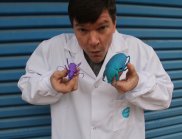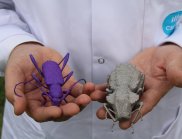Giant 3D printed bugs shed light on insect anatomy
Minute insects, from the Australian National Insect Collection, have been super sized by up to forty times using a novel 3D scanning system and printed using a state of the art 3D printer.
The 3D bugs show new potential for entomologists studying the anatomy of miniscule creatures by enabling them to physically handle the insects and study their features up close.
The 3D bugs show new potential for entomologists studying the anatomy of miniscule creatures by enabling them to physically handle the insects and study their features up close.
Scientists believe this technology will soon enable them to determine characteristics, such as gender, and examine surface characteristics which are otherwise difficult due to the minute size.
Originally created for a national art exhibition, CSIRO Science Art Fellow Eleanor Gates-Stuart, said the bugs they are working with are micro sized, some only clearly visible under the microscope.
“We combined science and art to engage the public and through the process we’ve discovered that 3D printing could be the way of the future for studying these creatures,” she added.
To create the bug, scientists scan the insect to generate a computer aided design (CAD) file. The CAD file is then entered into the 3D printing machine.
CSIRO’s Additive Manufacturing Operations Manager, Chad Henry, said that compared to conventional methods of manufacturing, 3D printing is highly efficient and environmentally friendly.
“The process is perfect for building fine scale features to capture all of the intricate details of the bugs,” he said.
The 3D printing machine adds layer upon layer of titanium to build up each bug. Up to 12 bugs can be produced at a time and after 10 hours in the machine; the bugs emerge from the titanium powder.
“Giant bug production is not necessarily where we saw ourselves going, however, this project is exciting because it brings together two key areas of science – manufacturing and entomology,” Chad Henry added.
CSIRO’s additive manufacturing facility, Lab 22, is currently being used to manufacture a range of prototype products including biomedical implants, automotive, aerospace and defence parts for Australian industry.
Media resources
Click image for high resolution version


